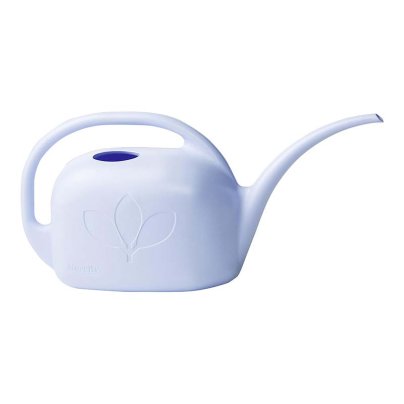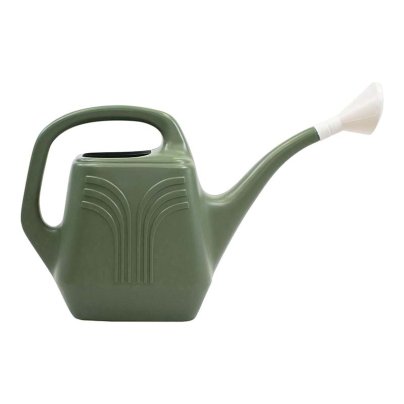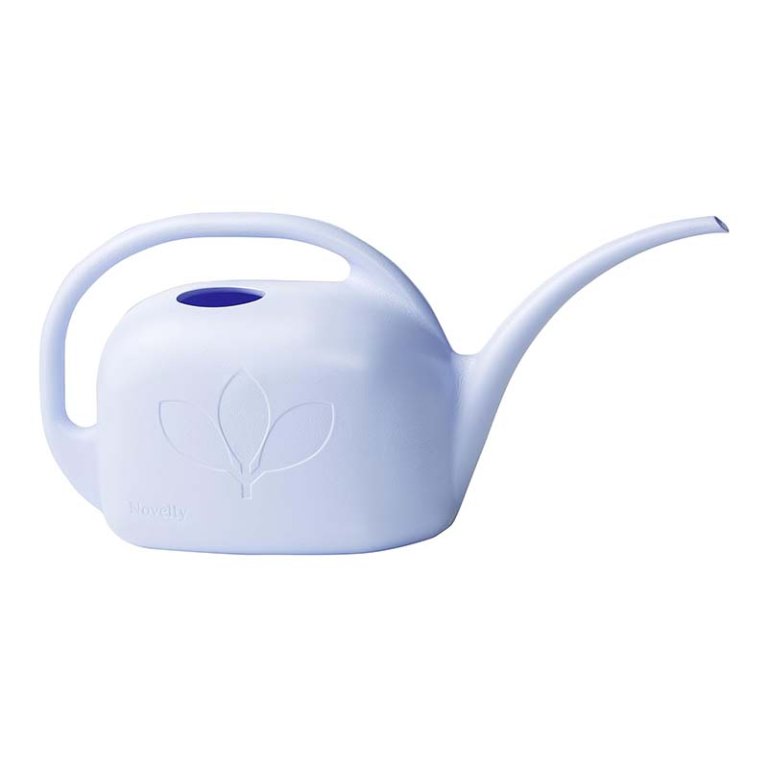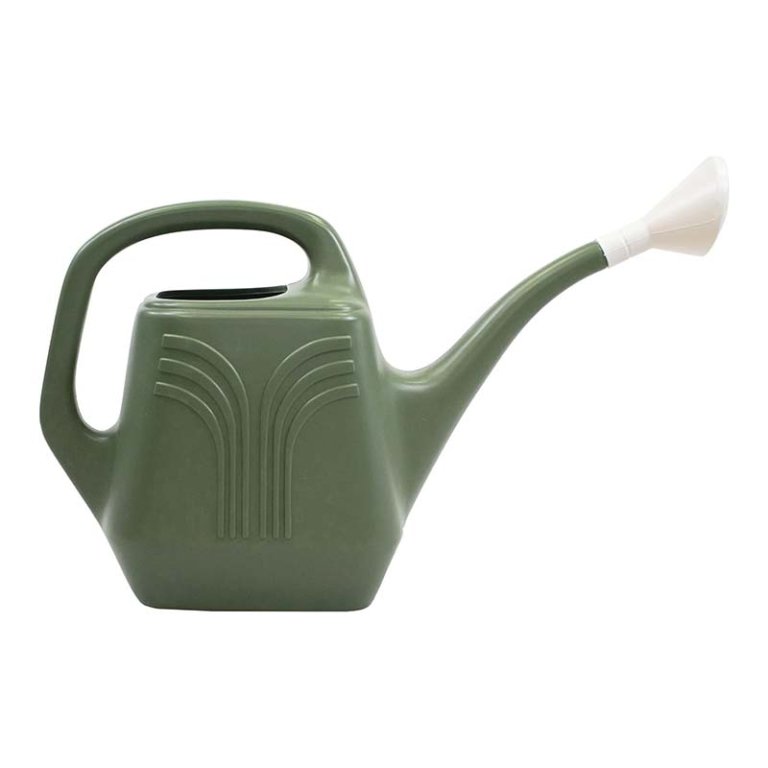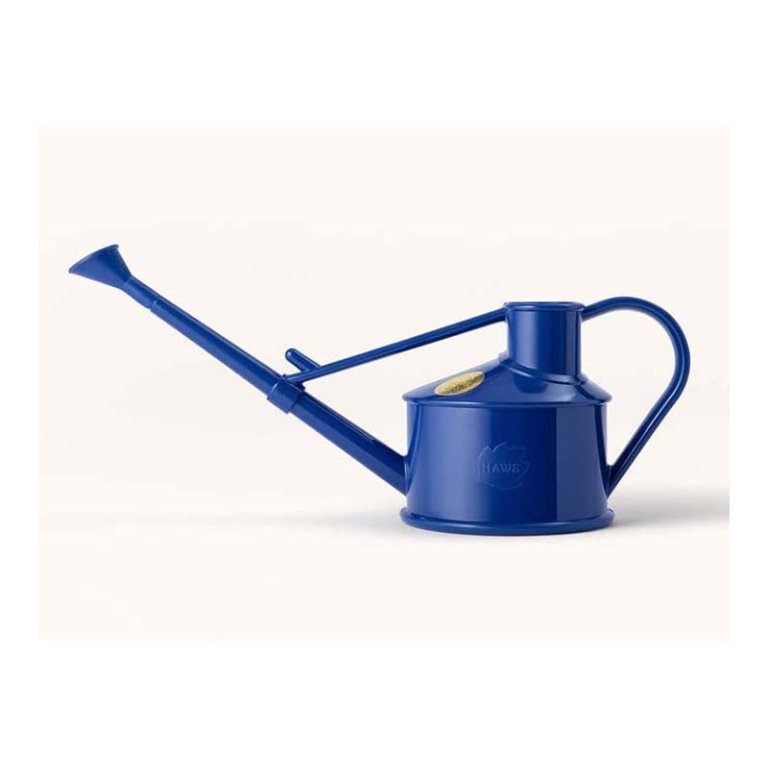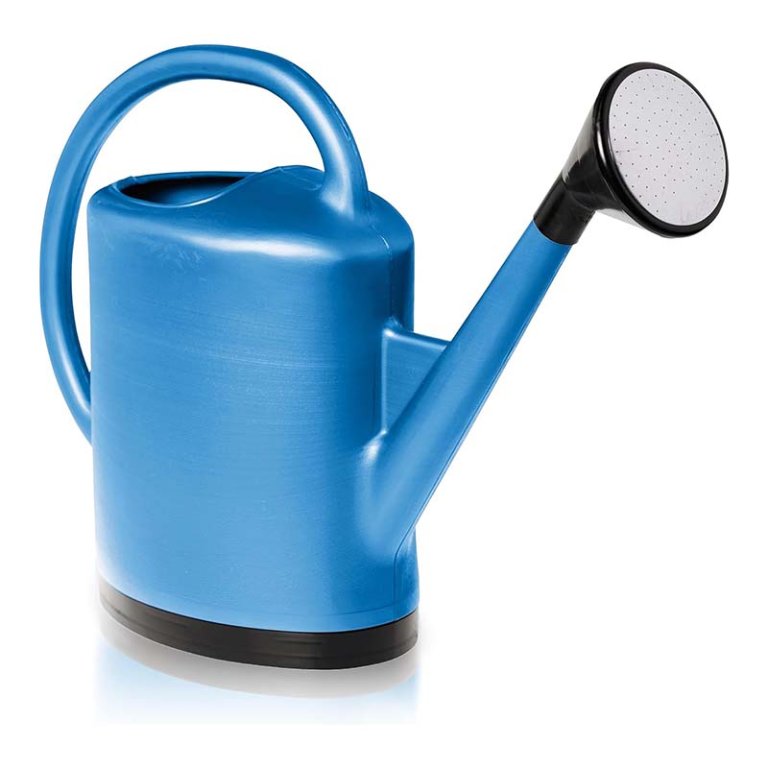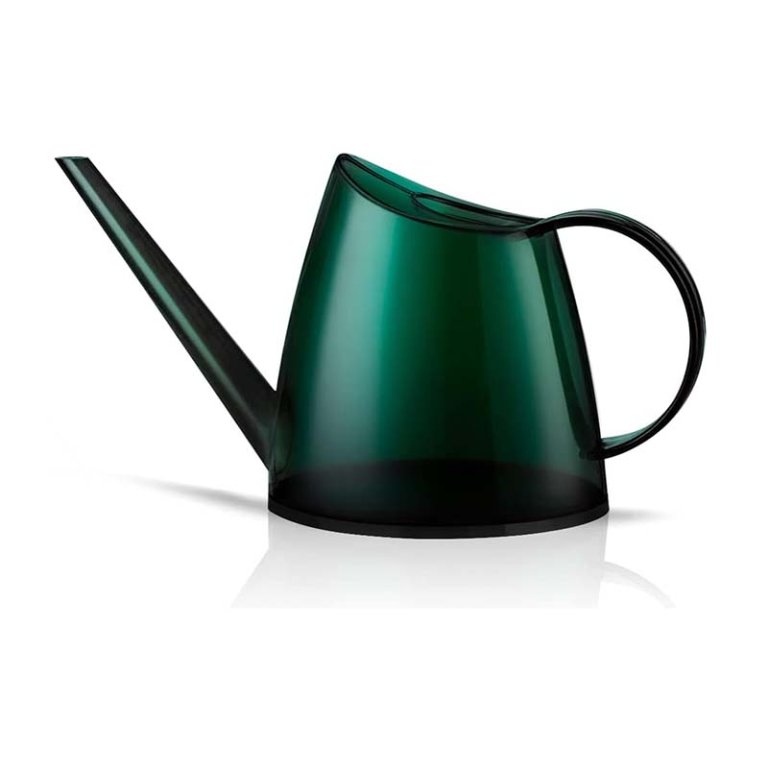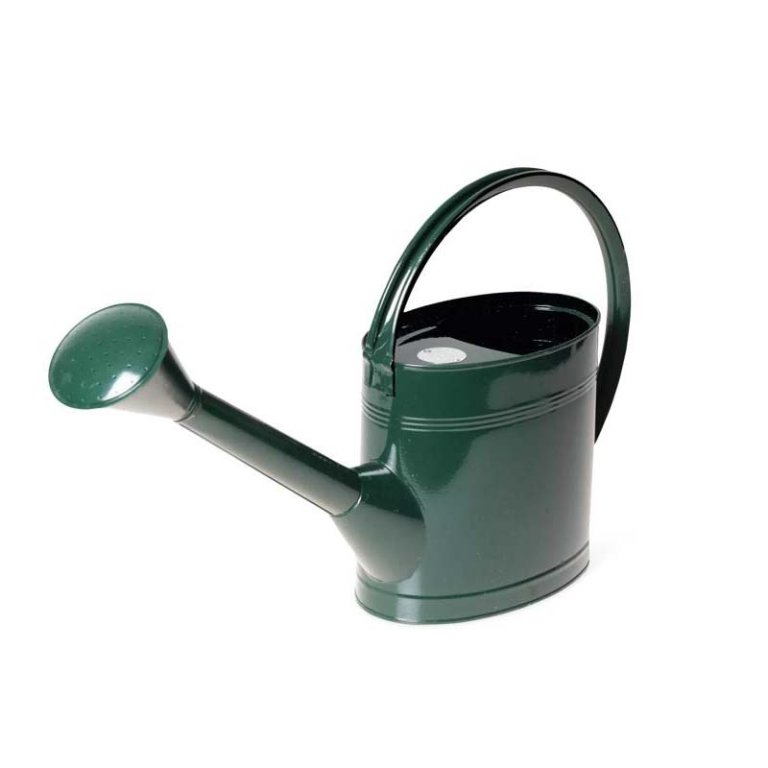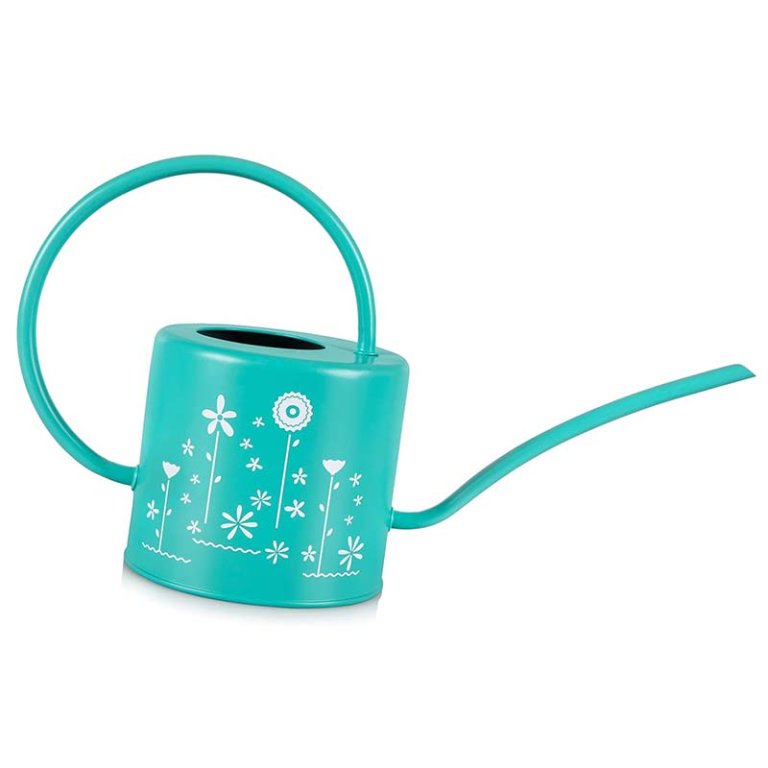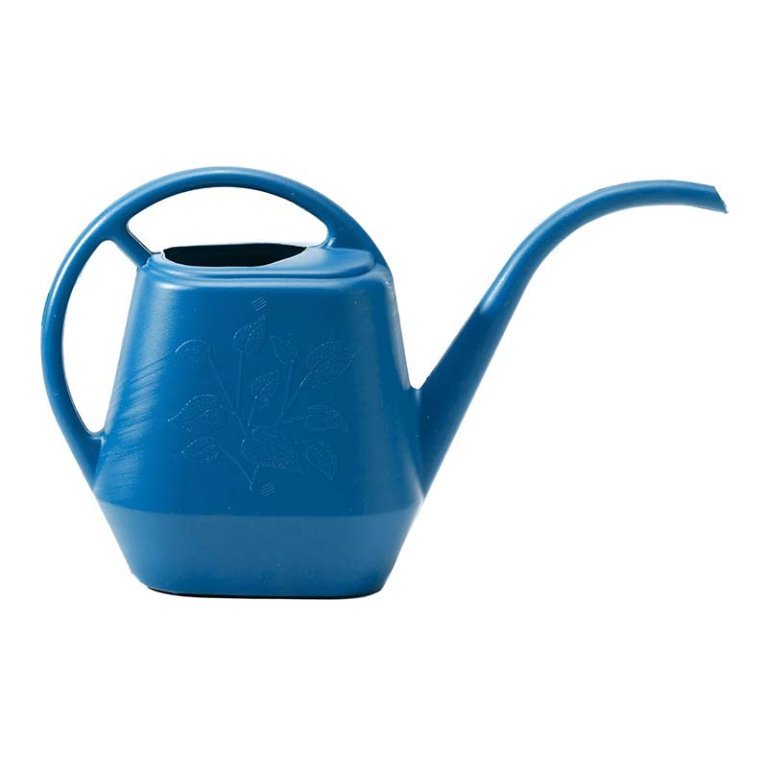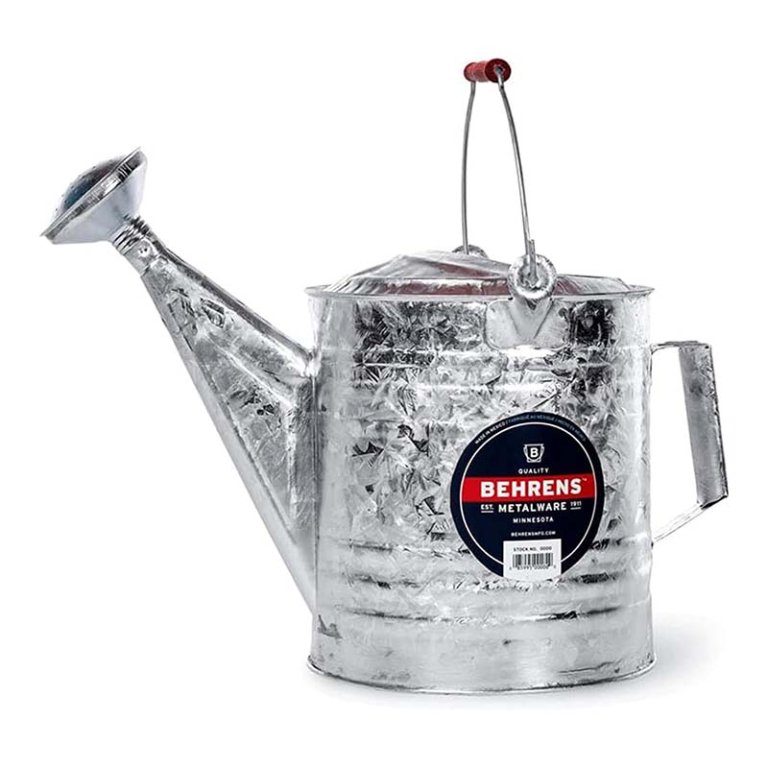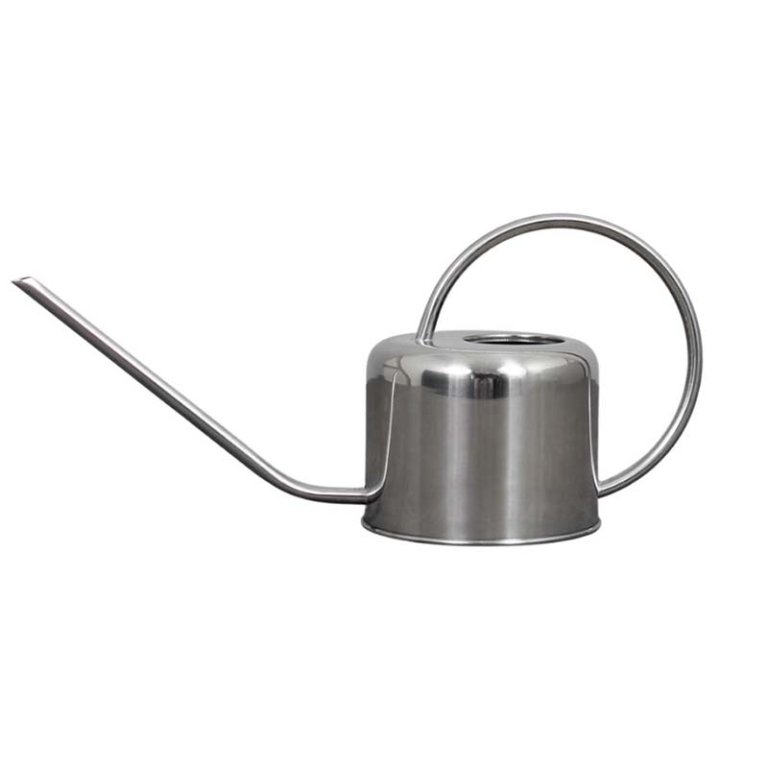
We may earn revenue from the products available on this page and participate in affiliate programs. Learn More ›
Whether you care for houseplants or an outdoor garden, watering cans are some of the handiest tools in your arsenal. They are a convenient way to water thirsty potted plants instead of bringing them to the sink, and they can eliminate wrestling with a garden hose. But finding the right one for the job can be tough. After researching more than 40 watering cans of different sizes, designs, and prices, we tested 10 of the most promising options to find the best of the best.
A suitable water can for gardening must have adequate capacity, durable construction, comfortable weight and balance, and the right water delivery system to make caring for your plants more convenient. Our favorite option, a sturdy and sweet model from Novelty Manufacturing Co., earned our top spot thanks to its user-friendly design, impressive capacity, and affordable price point. Learn more about this watering can for plants and the rest of our picks by checking out the results of our testing below. Later on, we will offer our top tips for choosing the best watering cans for watering plants.
- BEST OVERALL: Novelty Manufacturing Co. Watering Can
↓ Jump to Review - BEST BANG FOR THE BUCK: Bloem Promo Watering Can
↓ Jump to Review - BEST INDOOR: Haws The Langley Sprinkler Watering Can
↓ Jump to Review - BEST OUTDOOR: Gardener’s Supply Company French Blue Watering Can
↓ Jump to Review - BEST FOR HOUSEPLANTS: WhaleLife Long-Spout Watering Can
↓ Jump to Review - BEST FOR SEEDLINGS: Gardener’s Supply Company Long-Reach Watering Can
↓ Jump to Review - BEST FOR DISPLAY: Homarden Copper Watering Can
↓ Jump to Review - BEST PLASTIC: Bloem Aqua Rite Watering Can
↓ Jump to Review - BEST GALVANIZED: Behrens Hot-Dipped Steel Wooden Handle Watering Can
↓ Jump to Review - BEST STAINLESS STEEL: FastGrowingTrees Stainless Steel Watering Can
↓ Jump to Review
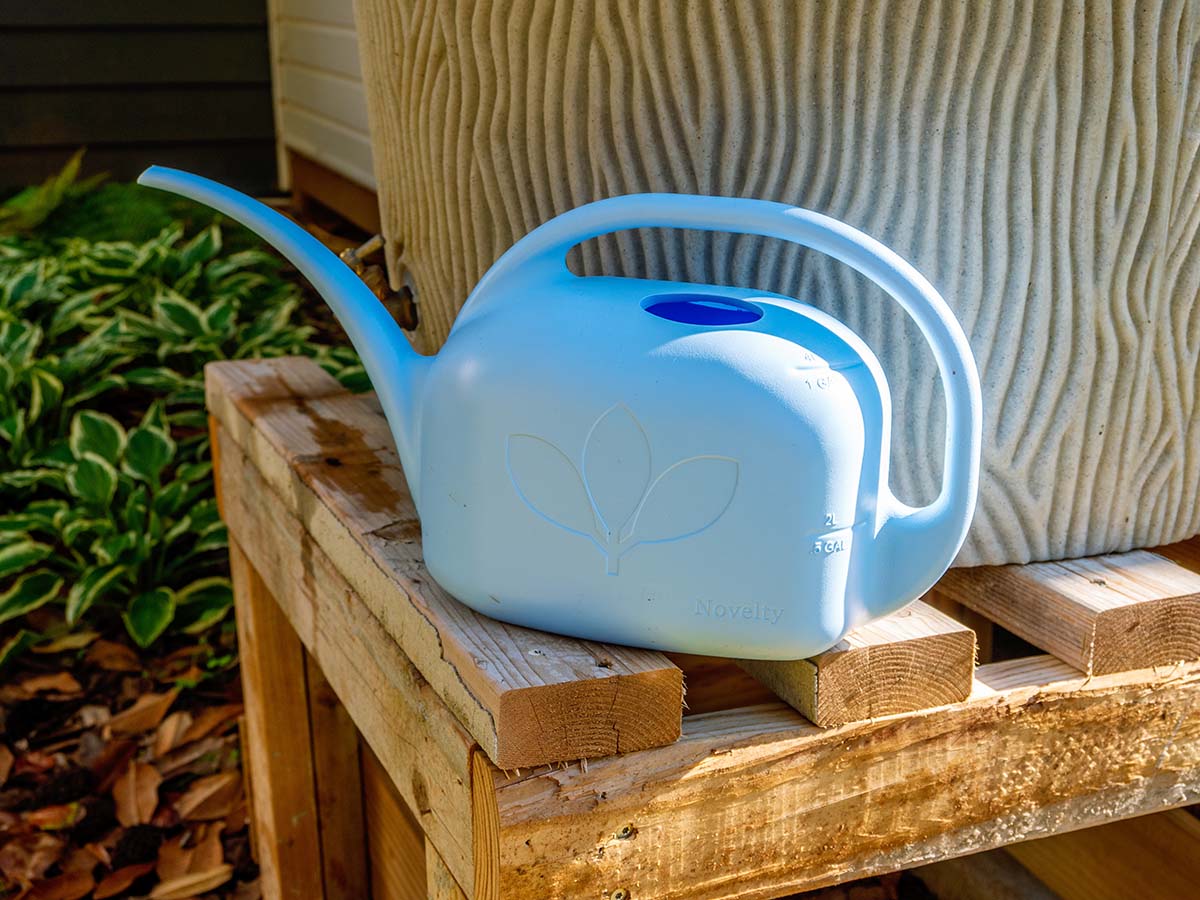
How We Tested the Best Watering Cans
The right watering can for a small collection of houseplants differs greatly from one for a backyard vegetable garden. We tested a full range of models so that our readers would have multiple options to consider, whether they care for an indoor garden with five small plants or five intensively planted acres. With that in mind, our tests were less concerned with head-to-head comparisons and more with each tool’s ability within its intended use case.
After recording dimensions and construction details, we spent a half hour watering with each model. We noted our observations with regard to ease of filling, weight and balance while carrying, ease of controlling the flow while pouring, and the force of the pour or shower pattern. Then, we compiled our notes on a scoring rubric and answered a subjective questionnaire in order to determine product ratings.
| Testing Stats | |
| Products tested | 10 |
| Hours spent testing | 5 hours |
| Tests performed | 4 |
| Price range | $7.00 to $70.00 |



Our Top Picks
Even an automated watering system sometimes needs support from a watering can. There are several important features to consider when shopping for one that will work for your needs. We researched and tested these models to help make it easier. From antique-looking galvanized steel to modern designs, one of these watering cans may be right for you.
Best Overall
Novelty Manufacturing Co. Watering Can
Pros
- Holds plenty of water, which means fewer trips back to the faucet for filling
- Durable and inexpensive plastic watering can resists dents and leaks
- Plastic material is safe for use with liquid garden fertilizer
- High, narrow spout pours a clean stream of water that is easy to control
- Dual openings make it easy to fill while reducing spills
Cons
- The rounded blocky shape of the can and elongated handle easily becomes off-balance
- May be too heavy for comfortable 1-handed pouring when full
Product Specs
- Volume: 1 gallon
- Material: Plastic
- Sprinkle or pour: Pour
Our Ratings: Handle(s) 4.5/5; Balance 5/5; Water Flow 5/5; Durability 5/5; Value 4.8/5
Comfortably water all day long using this watering can designed for ease of use. It has a long, low handle that allows users to adjust their hands while water drains from the can. Both hands can fit on the handle if needed during the pour, and it’s easy to find a comfortable spot while carrying.
Made with shatterproof recycled plastic, the durable watering can is both ultraviolet (UV)- and frost-resistant. The small spout opening offers good water flow control, and the long stem reaches difficult-to-access spots. The can has two offset holes at the top for easy filling in a sink, in a tub, or with a hose. It holds 1 gallon of water and is embossed with water-capacity measurements.
This was our favorite water can for indoor plants and outdoor plants alike because it held a good volume of water for container gardening without becoming too heavy. The narrow spout was the perfect size for small and midsize potted plants, and it curved just right for a smooth pour from start to finish. The blocky shape of the body and low elongated handle were slightly awkward for one-handed pouring when the reservoir was full, but it balanced well for carrying.
Get the Novelty Manufacturing Co. watering can at Amazon or Family Hardware.
Best Bang for the Buck
Bloem Promo Watering Can
Pros
- Lightweight and inexpensive yet stands up to hard outdoor use
- Holds a large volume of water to reduce trips between faucet and planters
- Thick loop handle for comfortable 1-handed or 2-handed operation
- Removable rose accommodates watering with a steady stream or shower
Cons
- Rose drips around the base so that the shower flow is not perfectly smooth
Product Specs
- Volume: 2 gallons
- Material: Plastic
- Sprinkle or pour: Both
Our Ratings: Handle(s) 4.5/5; Balance 5/5; Water Flow 4.5/5; Durability 4/5; Value 5/5
A lightweight build, large volume, and balanced design earned the Bloem Promo watering can our value pick. It’s cheap enough to buy one for each hand and spend half as much time walking back to the faucet for refills.
This durable plant watering can holds 2 gallons of water. It features an upright reservoir configuration with a fun botanical pattern embossed on the sides. The modest-size fill hole easily fits under a backyard spigot but minimizes water sloshing while carrying. The thick loop handle wraps from just in front of the fill hole to the lower rear of the reservoir for balanced transport and pouring. The removable rose gives you the choice of a gentle shower or a soaking stream while watering.
This was hands-down the best value of the test group, especially for outdoor gardeners who value water volume and functionality. The rose went on and off easily enough and held securely while in use, but it dripped steadily as we showered our plants. The shower pattern was moderately forceful but not strong enough to flatten our new vegetable seedlings. The lightweight construction of this can was highly impact-resistant and great in all aspects except one: It was prone to blowing around in strong winds.
Get the Bloem Promo watering can at Amazon, Lowe’s, or DK Hardware.
Best Indoor
Haws The Langley Sprinkler Watering Can
Pros
- Classic Haws watering can design in a miniature size that looks great and works well
- Injection-molded plastic construction is lightweight and resistant to damage and corrosion
- Includes removable brass-faced rose with onboard storage so it doesn’t get lost
- Easy to control gentle stream or fine shower; ideal for delicate plants
Cons
- Premium price for an attractive design from a revered brand
Product Specs
- Volume: 16 ounces
- Material: Plastic
- Sprinkle or pour: Both
Our Ratings: Handle(s) 5/5; Balance 5/5; Water Flow 5/5; Durability 4/5; Value 4.7/5
Indoor watering cans can be purely functional, but style counts, too. The Langley Sprinkler watering can from Haws offers both form and function. This option features a nostalgic garden watering can design in a miniature size that is perfect for maintaining indoor plant collections and could even serve well as a decorative vase.
This injection-molded plant watering canister has a raised fill hole to eliminate sloshing. The reservoir holds 16 ounces of water. It comes with a removable brace-faced rose for your choice of a fine shower or a steady stream of water. When not in use, the rose can be stored on the built-in storage nub at the front of the handle, just like the one on its full-size counterpart.
Those with larger hands may find this mini watering can more attractive than practical. The scaled-down design really looks nice, but the handle is a bit too thin and doesn’t have quite enough clearance above the top of the reservoir to be comfortable in hand. However, the pour is smooth with or without the rose, and the modest flow rate is just right for small potted plants. We don’t water every day, so enjoying the added decorative value makes it all the better.
Get the Haws watering can at Amazon or Haws.
Best Outdoor
Gardener’s Supply Company French Blue Watering Can
Pros
- Extra-large capacity lets you walk less and water more plants per can
- Durable, heavy-duty plastic can resists UV damage for years of service
- Removable rose lets you choose between a gentle shower or a steady stream
- Tall can with oval profile and large loop handle for easy carry and pour
Cons
- Loose-fitting rose may leak or slip off during use
Product Specs
- Volume: 3 gallons
- Material: Plastic
- Sprinkle or pour: Both
Our Ratings: Handle(s) 5/5; Balance 5/5; Water Flow 5/5; Durability 5/5; Value 5/5
For intensive gardeners who do a lot of watering by hand, a garden hose with a watering wand might work, but dealing with the hose can be a pain. For hard-to-reach areas, a large watering can reduces the number of trips from the faucet to thirsty garden plants. The Gardener’s Supply Company French Blue watering can was the largest in our test group. It has an easy-to-carry upright design with a thick loop handle for balance and a removable rose that produces an incredibly gentle shower flow. The can holds up to 3 gallons of water so that you can finish the job quickly.
While researching products to test for this guide, we were a bit standoffish about this can. Several reviewers reported that the rose easily falls off the end of the spout while in use, and it would be quite heavy with a full 3 gallons of water in the reservoir. After testing, we were glad that we included it. The proportions of the can are well balanced for comfortable use even when full, and although the rose slipped on and off easily, it did not fall off or leak during our tests. In fact, it produced the best gentle shower flow of all tested watering cans, with no drips. Also of note, the French Blue watering can was lighter than a metal can but heavy enough to resist blowing around in the wind.
Get the Gardener’s Supply Company French Blue watering can at Amazon or Gardener’s Supply Company.
Best for Houseplants
WhaleLife Long-Spout Watering Can
Pros
- Transparent resin watering can offers easy visibility of the contents
- Stylish rear handle design complements contemporary decor
- Small watering can with long stem spout pours a clean and gentle drip-free stream
Cons
- Rear handle design is less suitable for carrying than for pouring
Product Specs
- Volume: 40 ounces
- Material: Plastic
- Sprinkle or pour: Pour
Our Ratings: Handle(s) 4.5/5; Balance 4/5; Water Flow 5/5; Durability 5/5; Value 4.5/5
This watering can from WhaleLife holds 40 ounces of water and features a transparent reservoir that allows you to see the current water level. The long-stem spout can sneak past foliage to reach the base of the plant and ensure water gets where it’s needed most.
This watering can is ideal for indoor plants such as bonsai and succulents. It’s available in eight colors, and the fluent lines and chic aesthetic bring a touch of character to any garden. It’s made of thickened polystyrene resin and is built firm and robust for a long-lasting solution.
In testing, we quickly noticed that this is a watering can meant for pouring, not necessarily carrying. The quart-plus volume and rear handle design gave it the look and feel of a retro coffee pot. It was easy to control while pouring, and the handle was comfortable, but holding the full can for more than a minute or two without pouring was less so. It is a perfect choice for a collection of plants clustered in one room of the home.
Get the WhaleLife watering can at Amazon or Walmart.
Best for Seedlings
Gardener’s Supply Company Long-Reach Watering Can
Pros
- Sturdy galvanized steel construction with tough powder-coated finish
- Threaded rose produces a fine shower pattern that gently waters young plants
- Rolled-edge loop handle enhances user control during pouring
- Weighted toward the spout so that gravity enhances the pour
Cons
- The raised joint where the spout joins the can prevents fully emptying the can
Product Specs
- Volume: 1.3 gallons
- Material: Powder-coated galvanized steel
- Sprinkle or pour: Both
Our Ratings: Handle(s) 4.5/5; Balance 5/5; Water Flow 5/5; Durability 5/5; Value 4.7/5
When it comes to young seedlings and flowers, a watering can with a longer spout and fine rose is ideal for moistening the soil without flattening the foliage. This flower watering can boasts a refined weight-forward design and wide loop handle that make watering feel almost automatic. The removable rose produces a fine, textured shower pattern that is perfect for seedlings.
The Gardener’s Supply Company long-reach watering can is manufactured by legacy tool maker Burgon & Ball and endorsed by the Royal Horticultural Society of the United Kingdom. It is made of galvanized steel with a tough powder-coat finish that makes it extremely resistant to rust and corrosion.
This watering can was one of the most comfortable to use, even though it was a bit heavier than the plastic models. The volume was just right for greenhouses, raised garden beds, and patio work, where the faucet is never far away. The high arc handle left plenty of room beneath for easy filling. The price was a bit higher than most others, but the premium materials and construction quality seemed to warrant the cost. As with other metal watering cans, this one is nearly impossible to empty completely due to the low ridge at the joint where the spout attaches to the reservoir.
Get the Gardener’s Supply Company long-reach watering can at Gardener’s Supply Company.
Best for Display
Homarden Copper Watering Can
Pros
- Attractive copper-finished steel watering can adds a vintage touch
- Compact size makes it easy to stow and easy to fill
- Smooth stream and long spout minimize soil disturbance when watering
- Durable steel construction designed to last for years
Cons
- Impossible to empty completely due to the construction of the spout
Product Specs
- Volume: 60 ounces
- Material: Metal
- Sprinkle or pour: Pour
Our Ratings: Handle(s) 4.5/5; Balance 4/5; Water Flow 5/5; Durability 5/5; Value 4.5/5
Pretty enough to display on a bookshelf or table, the Homarden copper-colored watering can combines form and function. The retro-styled can is ideal for watering small houseplants. At just 15 inches long and 8 inches tall, this watering can has a 60-ounce capacity.
Its long, narrow spout makes it easy to deliver water to plants that despise wet foliage (like African violets). Copper-colored paint covers the stainless steel watering pot for a charming look. While it can be used to water both indoor and outdoor plants, you’ll want to store this watering indoors to help prevent rusting.
This compact watering can is great because it is small enough to fit just about anywhere, and it looks like art. We really liked the retro styling of the copper color and the one-piece curved handle that penetrates the base of the reservoir and emerges on the opposite side as the spout. The long, narrow spout produced a thin stream that easily reached beneath the foliage and avoided disturbing the soil. Although it was small, filling up at the kitchen sink was not a problem.
Get the Homarden watering can at Amazon or Walmart.
Best Plastic
Bloem Aqua Rite Watering Can
Pros
- Compact size stores easily and holds enough water for a few small plants
- Drip-free pour and smooth water stream minimize messes while watering
- Available in 3 cute colors: classic blue, earthy yellow, or Bermuda teal
- Budget-friendly and durable plastic construction
Cons
- Long spout makes it difficult to water plants in elevated locations, such as a tall shelf
Product Specs
- Volume: 56 ounces
- Material: Plastic
- Sprinkle or pour: Pour
Our Ratings: Handle(s) 4/5; Balance 5/5; Water Flow 5/5; Durability 5/5; Value 5/5
Nourish plants indoors or outdoors for years to come with this Bloem plastic resin watering can. It is 100 percent UV stabilized to safeguard against fading colors and withstand harsh weather conditions, meaning it’ll last a long time and look good to boot.
The Aqua Rite’s streamlined design features a one-piece construction to avoid leaks and a long stem spout to help control water flow to smaller plants and flowers. The long curved handle allows the user to hold the can with two hands or one—great for switching between pouring and carrying. The can holds up to half a gallon of water. Available in several colors, this watering can also has a floral design on the side that adds to its character.
During our research, we noted several reviews that complained of its small size. While the description on Amazon includes the phrase “large capacity,” our measurements confirmed the claimed 56-ounce capacity, which is a little less than a half gallon. We recommend cans of this size for maintaining collections of smaller plants.
We really liked the size and shape of this can. The reservoir was taller than it was wide, so it saved space in storage (which, in our case, was simply sitting among the plants on the shelf). The loop handle was a bit too skinny for our gripping comfort but was shaped perfectly for smooth pouring.
The spout rises well above the reservoir’s height and curves well forward. This design made it easy to control the water flow at tabletop height and lower. However, it made it more difficult to water plants on a head-height shelf because of the steep tilt that was required.
Get the Bloem Aqua Rite watering can at Amazon, Ace Hardware, The Home Depot, or Walmart.
Best Galvanized
Behrens Hot-Dipped Steel Wooden Handle Watering Can
Pros
- Large 2.5-gallon capacity covers more plants per can
- Rose produces a wide shower pattern that is gentle on plants
- Dual-handle design for easy transport and control while pouring
- Heavy-duty galvanized steel construction to withstand harsh outdoor conditions
Cons
- Rose is not removable for faster pouring, which makes it more difficult to clear debris
- Galvanized metal is not suitable for dispensing liquid fertilizer
Product Specs
- Volume: 2.5 gallons
- Material: Galvanized steel
- Sprinkle or pour: Both
Our Ratings: Handle(s) 4.5/5; Balance 5/5; Water Flow 4.5/5; Durability 5/5; Value 5/5
The Behrens galvanized-steel outdoor watering can has a vintage look made to last, and it is constructed from recyclable materials. The can holds a lot of water: 2.5 gallons. Ideal for outdoor use, it won’t rust no matter how or where it’s stored.
The 14-inch-tall watering can emits a wide sprinkle pattern from the nonremovable rosette at the end of the spout. Handles at the top of the can and opposite the spout make it easy to carry and control water flow.
The modern farmhouse style emerges in the form of the watering can. If you are not interested in a cheap plastic model but prefer something that offers timeless toughness and pairs nicely with low-maintenance plants, then this may be the watering can you are looking for. The shiny silver galvanized construction cannot be ignored.
But styling aside, this rugged watering can has the weight and toughness for the outdoors. It was the only model we tested that didn’t blow around during our windy photo session. The dual-handle design made it fairly easy to carry and pour, although it required two hands for efficient pouring. Barring serious physical damage that would chip the finish, it will not rust. However, it should not be used to dispense liquid plant food, as the fertilizer may react with the galvanized finish.
Get the Behrens watering can at Amazon, Ace Hardware, Walmart, or Gemplers.
Best Stainless Steel
FastGrowingTrees Stainless Steel Watering Can
Pros
- Attractive design with clean lines and refined finish looks great on the plant bench
- Long, narrow spout makes it easy to water beneath lush foliage in crowded planters
- Compact size; convenient to store close at hand for touch-up watering
- Stainless steel material is safe to use with liquid plant food
Cons
- Small 30-ounce capacity is not ideal for extensive plant collections
Product Specs
- Volume: 30 ounces
- Material: Stainless steel
- Sprinkle or pour: Pour
Our Ratings: Handle(s) 4.5/5; Balance 4/5; Water Flow 5/5; Durability 5/5; Value 4.5/5
Stainless steel is durable, functional, and adds a refined aesthetic appeal that looks great in the garden and inside the home. The FastGrowingTrees stainless steel watering can is right sized for indoor use, looks good when sitting among the plant collection, and includes several features that add functional value.
This compact watering can has a 30-ounce water reservoir, a loop handle, and a narrow long-reach spout. Its modest capacity is just right for topping off extra-thirsty plants between major watering sessions. Since it is made of stainless steel, the can is also safe to use with liquid plant food.
We really liked the way the long spout reached down through dense foliage and deposited water directly onto the soil surface. The narrow spout and loop handle made it easy to control the flow, even with the smallest rooted cuttings and potted plants. It also made it easy to protect the tabletop by avoiding overflowing plant saucers and drippy foliage. It is quite small, however, so it is probably best for smaller plant collections.
Get the FastGrowingTrees watering can at FastGrowingTrees.
Jump to Our Top Picks
What to Consider When Choosing a Watering Can
Watering your plants, garden beds, and flowers doesn’t have to feel like a full-body workout. The right watering can may help. In addition to size and weight, whether you want a one- or two-handle can, the types of flowers and plants being watered, and the amount of water they need will all play key roles when selecting the best watering cans.
Size and Weight
Water weighs a lot, so the bigger the watering can, the heavier it will be when full. It’s important to determine how much water you can carry and what capacity will serve your needs. The added heft of a larger watering can mean fewer trips to the faucet for refills, but it’s probably overkill when watering just a few houseplants.
Most watering cans hold between 1 and 2 gallons. Smaller watering cans are ideal for houseplants, and larger-capacity watering cans are best for establishing newly planted shrubs, flowers, and seedlings.
Different-size watering cans are also helpful for fertilizing plants to keep them flowering throughout the growing season. Mixing the fertilizer in a watering can according to the product instructions delivers food and hydration directly to plant roots.
Material
Watering cans are available in different materials and vary in functionality—some are decorative in style, while others are more practical. Also, if you strictly water an indoor garden, something that rusts over time may not be an issue.
- Plastic: Lightweight and durable, plastic watering cans never rust and can last indefinitely if they’re not stored in direct sunlight. UV rays degrade plastic, which can lead to cracking and weakening of the watering can. They also tend to be less expensive than metal watering cans.
- Galvanized steel: For gardeners looking for a more vintage look, galvanized steel cans offer a nice rustic aesthetic. Though heavier than plastic, it will not rust like some metals.
- Stainless steel: A stainless steel watering can offers durability and will not rust. It is also heavier than other options.
- Aluminum: This is a type of sheet metal pot that comes in standard sizes. It is mainly used for indoor watering and small nursery gardens. Aluminum will not rust and is roughly one third lighter than steel.
- Copper and brass: While copper can develop a lovely patina as it ages and corrodes less quickly than other materials, it will eventually need to be replaced. It’s best to visually check the inside of copper watering cans every so often to look for evidence of corrosion, which is turquoise colored.
- Glass: Functional and decorative, glass watering cans definitely won’t rust. They can be considered attractive options, but they are breakable.
- Stoneware: Strong and durable stoneware watering cans come in various colors and patterns. Like glass and ceramic, stoneware will break relatively easily if dropped on a hard surface. With careful handling, it can last indefinitely.
- Ceramic: Because ceramic is made at lower temperatures than stoneware, it’s not quite as durable. It may chip more easily and break if dropped. Ceramic watering cans are made in a range of colors and patterns to add a little extra flourish to gardening chores.
Spout
It is important to consider how a watering can delivers water. Some pour, others sprinkle, and some include a feature called a rosette at the end of the spout that makes it easy to switch between the two.
Most houseplants benefit from a single spout that delivers water in a straight stream directly to the soil. Using the same spout on seedlings that require a gentler approach may likely uproot the delicate plants or snap their stems. Consider a longer spout when you want to extend a reach, like across a planting bed or for houseplants in hard-to-reach places.
One vs. Two Handles
Ideally, a watering can should feel comfortable to hold and operate. With larger-capacity cans, a two-handle design is especially helpful for water flow control and takes the strain off hands and wrists. Gardeners can use the top handle to carry the can and the lower handle to assist in pouring to get just-the-right flow.
Some large cans have a single continuous handle that curves from the top of the can to the back near the base to support two-handed pouring. Smaller cans often have a single handle.
Leak-Free Design
One-piece construction is a great feature of plastic watering cans because there are no seams for water to leak through. Cans like this are molded from one continuous piece of plastic. Conversely, any nongalvanized metal can is more likely to rust and ultimately leak.
A curved spout is important if the watering can is used for houseplants. This helps prevent leaking when filling the can at the tap or when moving from plant to plant.
FAQs
Now that you know more about watering cans, you may have some new questions popping up. For more information, check out these answers to some common queries. For other questions, contact the manufacturer.
A watering can lets you direct the water and control its flow. For certain plants or seedlings outdoors, a hose can be too strong and can cause damage. For an indoor garden with plants like succulents or cacti, a cup could make a mess. A long spout on a watering can helps direct the pour to the base of the plant for better watering without getting water outside of the pot. Different types of watering cans have various functions that help keep plants and flowers beautiful.
It may seem logical that a container intended to hold water can be left outdoors, but that is not always the case. Wind and sunlight complicate the issue. Lightweight watering cans may blow away in heavy winds, and UV sunlight causes plastic to break down prematurely. Heavy-duty metal or UV-protected plastic watering cans are best for permanent outdoor use.
Rust contains elements that naturally occur in soil. Under certain conditions, the rust can lower the pH of the water, but the effect is minimal. With the exception of highly sensitive plants and plants that need high pH, it is fine to use a rusty watering can.
After using a watering can, pour out any remaining water and rinse dirt and debris from the outside surfaces. Let it air dry and store it in a dry location to prevent rust or mold growth.
Meet the Tester
Mark Wolfe is a writer and product tester with a background in the nursery and landscaping industry. For more than 20 years he mowed, edged, planted, pruned, cultivated, irrigated, and renovated beautiful landscapes. Now he tests and writes reviews about the latest outdoor power equipment, hand tools, lawn care products, and other outdoor-living goods.
Additional research provided by Heather Blackmore and Tiffany Lewis.
